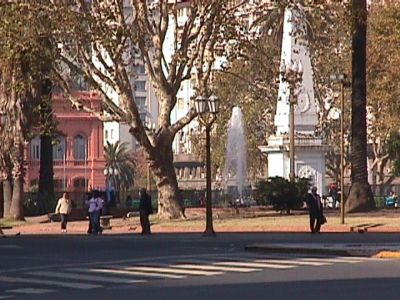Everything along Defensa Street, starting from Hipolito Irigoyen and the May Plaza, May Square, the heart o Buenos Aires, Everything along Defensa Street, one of the most visited and well known streets of the Historical art and antique area of the City of Buenos Aires,
Starting out from the May Square, la Plaza de Mayo, and the heart of this fabulous and romantic, vibrant City. We are to being our walk with our back to the Plaza and the central monumental there the Pyramid a homage to the May Revolution. The 25 of May of 1810. Plaza de Mayo and the Pyramid in its centre: Argentine lifetime Scenario ……….For more information: Email: admin@frassinetti.com Bob Frassinetti.
Press here to go back to web blog:Daily Updates on Art, Antiques, Collectibles as well as travel information for Buenos Aires, Argentina. Phone me thru Skype, ID: Bob Frassinetti or you can also chat with me thru Yahoo, press here:
Yahoo Contact Find me on MySpace and be my friend!
.
So this is a bit of the information on the Plaza and now to the Pink House
On October 17th 1945 there as a tremendous demonstration and a turning point in Argentine history, when countless millions of workers from all over the country gathered together at Plaza de Mayo to liberate Colonel Peron who was imprisoned in Martin Garcia Island. Not only was this the beginning of Argentina’s most popular politial movement ever, but also the first time the masses took over the public space for such notorious citizenship participation.
Latter on in June 16th, 1955, Plaza de Mayo was bombed by the Argentine Navy in an attempt of overthrowing President Peron. While the political move was unsuccessful, the result of the bombing was a massacre for the civilians who happened to be around the area. The president would resign three months latter in a coupe d’etat known as the Liberator Revolution.
During the 60s the continuance of dictatorships and civil governments made it very complicated for the people to gather in public spaces. However in 1973, when Peron returned from exile a massive demonstration took place on Labor Day 1974. It was another turning point in Argentine history, when he insulted the youth column of his peronist movement, fracturing his political strength and creating an unstable situation that would latter result into a very complicated and unstable political scenario.
The late 70s were a time of complicated political and social life in Argentina. Under a tremendous military government of unseen cruelty and terror, public demonstrations were vanished off the plaza. However, they couldn’t silence everyone. The Mothers of Plaza de Mayo -a group of social activists claiming for their children’s life- were some of the few who challenged the Military coupe d’ etat by publicly demonstrating every Thursday around the Pyramid. Their children were abducted by the militars in power and none of them was ever recovered. They are still struggling for justice for their children, and you can see them demonstrate every Thursday, as they have been doing for the past 30 years.
Plaza de Mayo has been the chosen spot to demonstrate and celebrate. In 1983, when the people on the streets finally overthrew the military dictatorship, the plaza was full.
However it is not only for political demonstrations that the Plaza is a symbol. When Argentina won the 1986 World Soccer Championship the plaza was also packed with Argentines and the Balconies of the Pink house filled with the Soccer Champions among which was the world’s greatest: Diego Armando Maradona.
In recent year the deepening of the Argentine crisis led the masses once again towards their demonstration center. On December 19th and 20th 2001, the Argentines made a strong statement by confronting with the Alianza government the future of the country. The people took over the public space in demonstrations all over the country demanding the president to resign together with all his collaborators. This finally happened on the afternoon of the 20th and after that there were several months of instability. It was a turning point in recent history for it implied a shift in Argentina’s public, social, cultural, political and economical life…
There’s no question about the central role this public plaza has played in Argentine history. It could very well be defined as the social thermometer of Argentina’s character.
Bob Frassinetti, art and antique dealer working from Buenos Aires, Argentina.
Everything on Art & Antiques as well as Travel Information for Buenos Aires and Argentina by Bob Frassinetti (Phone: +54 911 4475 3983 or in B's A's: 15 4475 3983 ) Invest in Argentina Real Estate an uprunning opportunity with a Future
More information, Photos and Links
Everything on Art & Antiques as well as Travel Information for Buenos Aires, Argentina, Chile and Uruguay by Bob Frassinetti
Photo Gallery for Defensa 251
Apartment Rent for Defensa 251
The May Plaza Photo Gallery
The Pink House Photo Gallery
Maps on Buenos Aires
A Revolution in the making Plaza de Mayo
More Video Clips on Buenos Aires and Argentina
Topic: Buenos Aires Historical
Everything on Art & Antiques as well as Travel Information for Buenos Aires, Argentina, Chile and Uruguay by Bob Frassinetti
Photo Gallery for Defensa 251
Apartment Rent for Defensa 251
The May Plaza Photo Gallery
The Pink House Photo Gallery
Maps on Buenos Aires
A Revolution in the making Plaza de Mayo
More Video Clips on Buenos Aires and Argentina
Topic: Buenos Aires Historical





